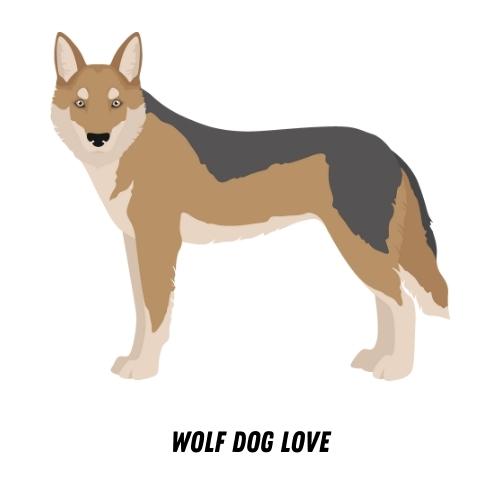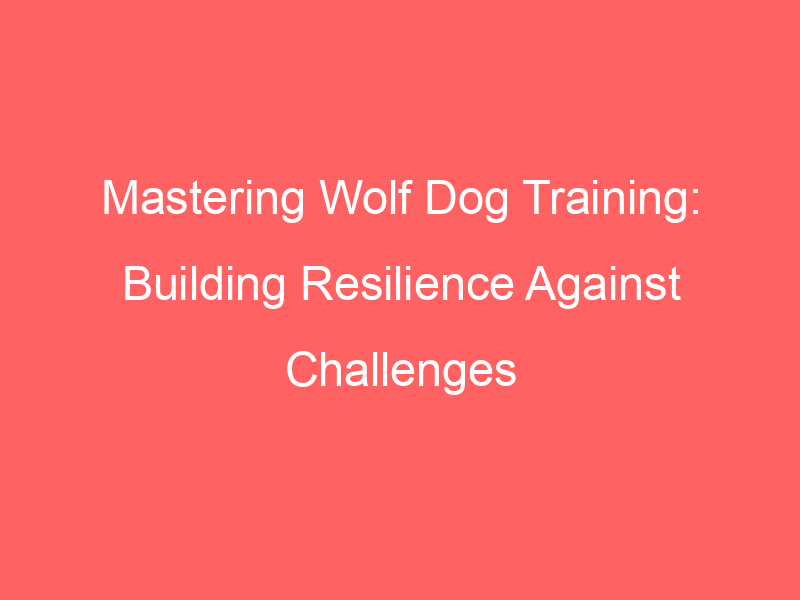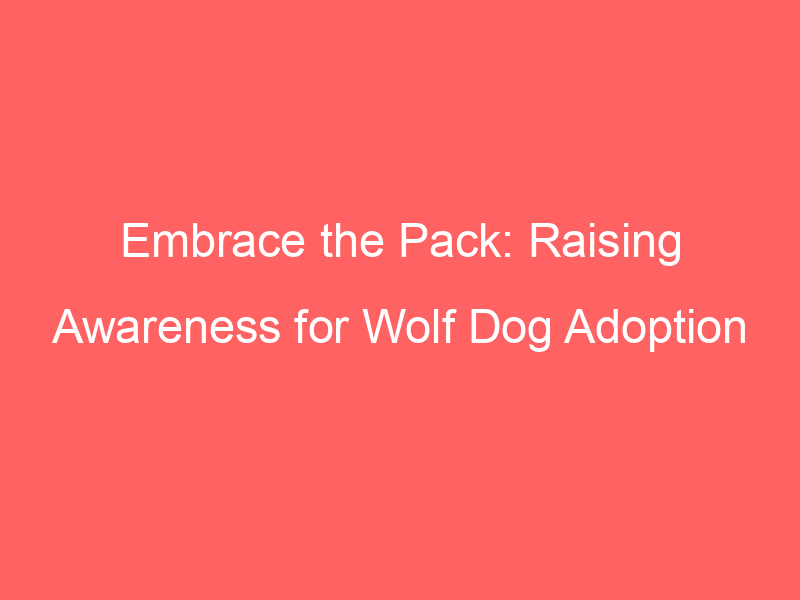Understanding Wolf Dog Behavior
Wolf dogs are unique creatures that combine the traits of domestic dogs and wild wolves. Understanding their behavior can help you connect with them better and provide them with the care they need. In this section, we’ll explore the unique traits of wolf dogs, their instinctual behavior, and how their behavior differs from other dog breeds.
- Recognizing the unique traits of wolf dogs
- Understanding the instinctual behavior of wolf dogs
- How wolf dog behavior differs from other breeds
Wolf dogs are a unique blend of domestic dog and wild wolf. This gives them a set of characteristics that are distinct from other dog breeds. For instance, they are typically more independent, intelligent, and have a stronger prey drive. They also tend to be more curious and explorative, often showing a keen interest in their surroundings. Recognizing these traits can help you understand your wolf dog better and adapt your care and training methods accordingly.
Wolf dogs, like their wild ancestors, have certain instinctual behaviors. These include a strong desire to roam and explore, a natural inclination towards pack behavior, and a tendency to communicate through howls and other vocalizations. Understanding these instincts can help you provide an environment that caters to their needs and helps them feel secure and content.
Wolf dogs differ from other breeds in several ways due to their unique genetic makeup. They tend to be more independent and may require more time and patience to train. They also have a stronger prey drive and may be more likely to chase after small animals. Additionally, they often communicate differently, using more vocalizations and body language. Understanding these differences can help you tailor your approach to training and caring for your wolf dog.
In conclusion, understanding wolf dog behavior requires recognizing their unique traits, understanding their instinctual behaviors, and acknowledging how they differ from other breeds. With this knowledge, you can provide the best care for your wolf dog and build a strong, positive relationship with them.
Wolf Dog Training Techniques
Training a wolf dog can be a challenging yet rewarding experience. These unique animals require a special approach to training, which we will explore in this section.
Basic Training Techniques
Before we delve into the more advanced techniques, it’s important to understand the basics. Here are three fundamental techniques that form the foundation of successful wolf dog training.
-
Establishing Dominance and Respect
Wolf dogs are pack animals, and in every pack, there’s a leader. As their owner, you need to establish yourself as the pack leader. This doesn’t mean being aggressive or harsh. Instead, it’s about showing confidence, setting boundaries, and being consistent. This helps your wolf dog understand their place in your family and respect you as their leader.
-
Using Positive Reinforcement
Positive reinforcement is a powerful tool in wolf dog training. This involves rewarding your wolf dog for good behavior, which encourages them to repeat it. Rewards can be in the form of treats, praise, or playtime. Remember, it’s important to reward your dog immediately after they display the desired behavior, so they associate the reward with their action.
-
Consistency in Training
Consistency is key in any form of training, and wolf dog training is no exception. This means maintaining the same commands, gestures, and rewards for each behavior. It also means training regularly and not just when you feel like it. Consistent training helps your wolf dog understand what is expected of them and makes the training process smoother and more effective.
These basic techniques are the building blocks of successful wolf dog training. By mastering these, you’ll be well on your way to having a well-trained, respectful, and happy wolf dog.
Advanced Training Techniques
After mastering the basics, it’s time to move on to more advanced training techniques. These techniques are designed to help your wolf dog become more obedient, agile, and social. They require a bit more time and patience, but the results are well worth it. Let’s delve into each one.
-
Training for obedience
Obedience training is crucial for any dog, but it’s especially important for wolf dogs due to their strong will and independent nature. This training involves teaching your wolf dog to follow commands like ‘sit’, ‘stay’, ‘come’, and ‘heel’. It’s not just about making your dog listen to you, but also about fostering a sense of respect and trust between you and your pet.
One effective technique is the ‘sit-stay-come’ exercise. Start by commanding your dog to ‘sit’. Once they’ve mastered that, add in the ‘stay’ command. Finally, introduce the ‘come’ command. Remember, patience is key. It may take several weeks for your dog to fully grasp these commands, but once they do, it will significantly improve their obedience.
-
Training for agility
Agility training is a great way to keep your wolf dog physically and mentally stimulated. It involves teaching your dog to navigate through an obstacle course, which can include jumps, tunnels, and weave poles. Not only does this improve their physical agility, but it also enhances their problem-solving skills.
Start with simple obstacles and gradually increase the difficulty as your dog gets more comfortable. Remember to always reward your dog for successfully completing an obstacle. This will motivate them to continue improving.
-
Training for socialization
Socialization training is all about helping your wolf dog feel comfortable around other animals and people. This is important because wolf dogs are naturally wary of strangers. By exposing them to different environments and individuals, you can help them become more confident and less anxious.
Start by introducing your dog to family members and friends, then gradually expose them to larger crowds. You can also take them to dog parks to interact with other dogs. Remember to always supervise these interactions to ensure they remain positive and safe.
Advanced training techniques require a lot of patience and consistency, but they can greatly improve your wolf dog’s behavior and quality of life. Remember, every dog is unique, so what works for one might not work for another. Always be patient, consistent, and positive in your training approach.
Overcoming Wolf Dog Training Challenges
Training a wolf dog can be a challenging task. However, with patience and the right approach, you can overcome these challenges. Here are some common problems you may encounter and how to address them:
- Dealing with aggressive behavior
- Addressing fear and anxiety
- Overcoming training resistance
Wolf dogs can sometimes exhibit aggressive behavior. This can be due to fear, dominance, or territoriality. It’s important to understand that aggression is a form of communication. Your wolf dog is trying to tell you something. Instead of punishing the aggression, try to understand its root cause. For example, if your wolf dog is aggressive when it comes to food, it may be due to hunger or fear of food scarcity. In such cases, regular feeding schedules and portion control can help alleviate the problem.
Wolf dogs can also suffer from fear and anxiety. This can be due to past traumas, lack of socialization, or genetic predisposition. It’s important to identify the triggers of your wolf dog’s anxiety and work on desensitizing them. This can be done through gradual exposure to the trigger, combined with positive reinforcement. For example, if your wolf dog is afraid of loud noises, you can gradually expose it to such noises while rewarding calm behavior.
Some wolf dogs may resist training. This can be due to a lack of motivation, confusion, or physical discomfort. It’s important to make training sessions fun and rewarding for your wolf dog. Use positive reinforcement techniques such as treats, praise, and play. Break down complex commands into smaller, manageable steps. And always ensure that your wolf dog is in good health before training sessions.
Remember, every wolf dog is unique and what works for one may not work for another. It’s important to be patient, consistent, and understanding. With time and effort, you can overcome these training challenges and build a strong, positive relationship with your wolf dog.
Fostering Resilience in Wolf Dogs
Building resilience in wolf dogs is crucial for their overall well-being. It helps them adapt to new situations, interact well with other dogs, and live a healthy, happy life. Let’s delve into how we can foster resilience in these magnificent creatures, focusing on building their confidence.
Building Confidence
Confidence is the cornerstone of resilience. A confident wolf dog is less likely to be fearful and more likely to engage positively with its environment and other dogs. Here are two key ways to build confidence in your wolf dog:
- Exposing to New Environments and Experiences
- Encouraging Interaction with Other Dogs
Introducing your wolf dog to new environments and experiences can significantly boost their confidence. This could be as simple as taking them to a new park, introducing them to new toys, or even changing their walking route. The key is to make these introductions gradual and positive, rewarding your dog for their bravery. Over time, your wolf dog will learn that new experiences are not something to fear, but something to embrace.
Interacting with other dogs can also help build your wolf dog’s confidence. This could be through organized playdates, doggy daycare, or simply visiting dog-friendly parks. Watching and interacting with other dogs can help your wolf dog learn appropriate social behaviors. Plus, playing with other dogs can be a great source of physical exercise and mental stimulation. Remember, always supervise these interactions to ensure they remain positive and safe.
In conclusion, fostering resilience in wolf dogs is a gradual process that requires patience and consistency. By exposing your wolf dog to new environments and experiences, and encouraging interaction with other dogs, you can help build their confidence and resilience. Remember, every wolf dog is unique, so what works for one might not work for another. Always tailor your approach to your wolf dog’s individual needs and personality.
Building Physical Resilience
Physical resilience is a key aspect of a wolf dog’s overall health and well-being. It involves two main components: regular exercise and a proper diet. Let’s delve into each of these aspects.
- Regular Exercise and Play
Just like humans, wolf dogs need regular exercise to maintain their physical health. Exercise helps to keep their muscles strong, their heart healthy, and their mind sharp. It also provides an outlet for their natural instincts and energy. Play is an important part of exercise, as it not only helps to keep them physically fit but also mentally stimulated.
According to a study, wolf dogs should get at least one hour of exercise each day, but ideally, they should have more. This can include walks, runs, playtime, and training sessions. Remember, a tired wolf dog is a happy wolf dog.
- Proper Nutrition and Diet
Proper nutrition is just as important as exercise in building physical resilience in wolf dogs. They need a balanced diet to ensure they get all the nutrients they need for their health and vitality.
Wolf dogs are carnivores, so their diet should be primarily meat-based. However, they can also benefit from certain fruits, vegetables, and grains. It’s important to consult with a vet or a pet nutritionist to determine the best diet for your wolf dog, as their nutritional needs can vary based on their age, size, and health status.
| Key Components of a Wolf Dog’s Diet |
|---|
| Protein (meat) |
| Fruits and Vegetables |
| Grains |
In conclusion, building physical resilience in wolf dogs involves a combination of regular exercise and a balanced diet. By ensuring your wolf dog gets plenty of exercise and eats a nutritious diet, you can help them live a long, healthy, and happy life.
Wolf Dog Training Tips
Training a wolf dog can be a challenging yet rewarding experience. Here are some essential tips to help you navigate this journey.
-
Patience and Persistence in Training
Training a wolf dog requires a great deal of patience and persistence. Unlike other dog breeds, wolf dogs have a strong instinctual nature that may make them more resistant to training. It’s important to remain patient and consistent in your training methods. Remember, it’s not about quick results, but about building a strong, trusting relationship with your wolf dog.
-
Understanding and Responding to Your Wolf Dog’s Needs
Understanding your wolf dog’s needs is crucial for successful training. Wolf dogs are highly intelligent and have unique needs compared to other breeds. They require plenty of physical and mental stimulation. Be observant and responsive to their behavior. If they seem restless or bored, it may be a sign that they need more exercise or mental challenges.
-
Seeking Professional Help When Needed
Don’t hesitate to seek professional help if you’re struggling with training your wolf dog. Professional trainers have the experience and knowledge to handle the unique challenges that come with training a wolf dog. They can provide you with the tools and techniques to effectively train your wolf dog and help you build a strong, positive relationship with your pet.
In conclusion, training a wolf dog requires patience, understanding, and the willingness to seek professional help when needed. With these tips in mind, you can create a positive and enriching environment for your wolf dog.
Case Studies: Successful Wolf Dog Training
Wolf dogs are unique creatures that require specialized training. Their wild instincts combined with their domesticated traits make them a challenge, but with the right approach, they can be successfully trained. Let’s explore some real-life case studies of successful wolf dog training.
Case Study 1: Overcoming Aggression
Aggression can be a common issue in wolf dogs due to their wild ancestry. However, with patience, understanding, and the right techniques, it can be managed. Let’s look at a case study of a wolf dog named Max.
Max was a 2-year-old wolf dog who was known for his aggressive behavior. His owners were at their wits’ end and didn’t know how to handle him. That’s when they sought the help of a professional wolf dog trainer.
The trainer started by observing Max’s behavior to identify the triggers for his aggression. It was found that Max became aggressive when he felt threatened or when his territory was invaded. The trainer then developed a plan to address these issues.
The first step was to establish trust with Max. The trainer spent time with him, feeding him, and playing with him. This helped Max see the trainer as a friend rather than a threat.
Next, the trainer worked on desensitizing Max to the things that triggered his aggression. This involved gradually exposing Max to these triggers in a controlled environment and rewarding him for calm behavior.
Over time, Max’s aggression decreased significantly. He became more comfortable around people and other animals, and his owners were able to manage him better. This case study demonstrates that even aggressive wolf dogs can be trained with patience, understanding, and the right techniques.
| Wolf Dog Name | Issue | Training Approach | Outcome |
|---|---|---|---|
| Max | Aggression | Establishing trust, desensitization, and positive reinforcement | Significant decrease in aggression, better management by owners |
In conclusion, overcoming aggression in wolf dogs is possible with the right approach. It requires understanding the dog’s triggers, establishing trust, and using positive reinforcement to encourage good behavior.
Case Study 2: Building Confidence in a Timid Wolf Dog
Meet Luna, a timid wolf dog who was once afraid of her own shadow. Luna’s story is a shining example of how patience, understanding, and the right training techniques can help a wolf dog overcome their fears.
Luna’s owner, Mr. Smith, reached out to us, expressing concern about Luna’s lack of confidence. She would often hide in the corner of the room, tremble at the sound of a doorbell, and avoid interaction with other dogs and humans.
The Training Approach
We began Luna’s training by focusing on building trust. We spent time with Luna, allowing her to get comfortable with our presence. We used positive reinforcement, rewarding her with treats and praise whenever she showed signs of confidence.
Progress and Success
Over time, Luna began to show signs of improvement. She started to explore her surroundings more and even began to interact with other dogs. After six months of consistent training, Luna was a changed wolf dog. She was confident, playful, and no longer afraid of her surroundings.
Key Techniques Used
| Technique | Description |
|---|---|
| Trust Building | Spent time with Luna, allowing her to get comfortable with our presence. |
| Positive Reinforcement | Rewarded Luna with treats and praise whenever she showed signs of confidence. |
| Consistent Training | Provided regular training sessions over a period of six months. |
Luna’s story is a testament to the power of patience and understanding in wolf dog training. It’s important to remember that every wolf dog is unique and requires a tailored approach to training. With the right techniques and a lot of love, even the most timid wolf dog can gain confidence and thrive.
Case Study 3: Training a Resilient Wolf Dog
Meet Max, a resilient wolf dog who was once considered a challenge to train. Max’s story is a testament to the power of patience, understanding, and the right training techniques.
Background
Max was adopted from a wolf dog rescue center at the age of two. His previous owners had not invested the time or effort to train him properly, which resulted in Max developing some undesirable behaviors. He was resistant to commands and had a tendency to be stubborn.
The Training Process
Max’s new owners decided to hire a professional wolf dog trainer. The trainer began by establishing a strong bond with Max, which is crucial in wolf dog training. This involved spending a lot of time with Max, understanding his behaviors, and earning his trust.
Next, the trainer used positive reinforcement techniques. Whenever Max followed a command or showed positive behavior, he was rewarded with treats or praise. This encouraged Max to repeat these behaviors.
Challenges and Overcoming Them
Training Max was not without its challenges. His stubbornness often led to resistance during training sessions. However, the trainer remained patient and consistent, never punishing Max for his stubbornness, but instead redirecting his energy into positive behaviors.
Results
After several months of consistent training, Max began to show significant improvements. He started responding to commands more readily and his stubbornness decreased. His owners reported that Max seemed happier and more relaxed.
| Before Training | After Training |
|---|---|
| Resistant to commands | Responds to commands |
| Stubborn | Less stubborn, more cooperative |
| Unhappy | Happier and more relaxed |
In conclusion, Max’s story shows that with patience, understanding, and the right training techniques, even the most resilient wolf dogs can be trained effectively.
Key Takeaways: Mastering Wolf Dog Training
Training a wolf dog can be a challenging yet rewarding experience. Here are the key takeaways from our comprehensive guide on mastering wolf dog training:
- Understanding your wolf dog’s unique needs and behaviors: Wolf dogs are not like other domestic dogs. They have unique needs and behaviors that stem from their wild ancestry. Understanding these needs and behaviors is the first step towards effective training. For example, wolf dogs are pack animals and need a strong, confident leader. They also have a high prey drive and need plenty of mental and physical stimulation.
- Utilizing effective training techniques: Positive reinforcement is the most effective training technique for wolf dogs. This involves rewarding good behavior with treats, praise, or play. It’s also important to start training early, be consistent, and use clear, simple commands. Remember, patience is key when training a wolf dog.
- Overcoming training challenges: Training a wolf dog can be challenging due to their independent nature and high intelligence. However, these challenges can be overcome with persistence and the right approach. If a particular training method isn’t working, don’t be afraid to try something new. Also, consider seeking help from a professional trainer experienced with wolf dogs.
- Fostering resilience in your wolf dog: Resilience is the ability to recover quickly from difficulties. In the case of wolf dogs, this means being able to adapt to new situations and overcome obstacles. Fostering resilience in your wolf dog involves providing a safe and stable environment, exposing them to a variety of experiences, and encouraging problem-solving skills.
In conclusion, mastering wolf dog training requires understanding your pet’s unique needs, using effective training techniques, overcoming challenges, and fostering resilience. With patience, consistency, and the right approach, you can build a strong, trusting relationship with your wolf dog and help them become a well-behaved, confident, and happy member of your family.








